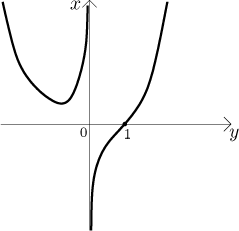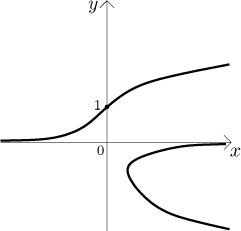Problem: Prove that the equation
Solution: We start by checking that the question makes sense: The
couple
For the proof we use the Implicit function theorem with
We find the appropriate partial derivative and substitute.
![]()
We got a non-zero number, so the Implicit function theorem proves what was needed.
Remark: It seems impossible to reasonably express y from this equation, so any direct way to get a functional description of this curve is not possible. However, we can determine the shape of this curve using a little trick. Note that we can express x from the given equality. Thus we can "switch axes" in the picture and treat y as the free variable and x as the dependent one. We get
![]()
We can apply the usual graph sketching procedure (see Graphing in Derivative - Theory or Graphing in Derivative - Methods Survey) and obtain this sketch:

However, we switched axes when doing this work, so we have to fix the picture to get it right.

As you can see, on a neighborhood of
Next problem
Back to Solved Problems - Implicit
and parametric functions